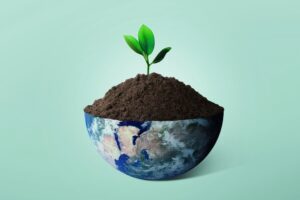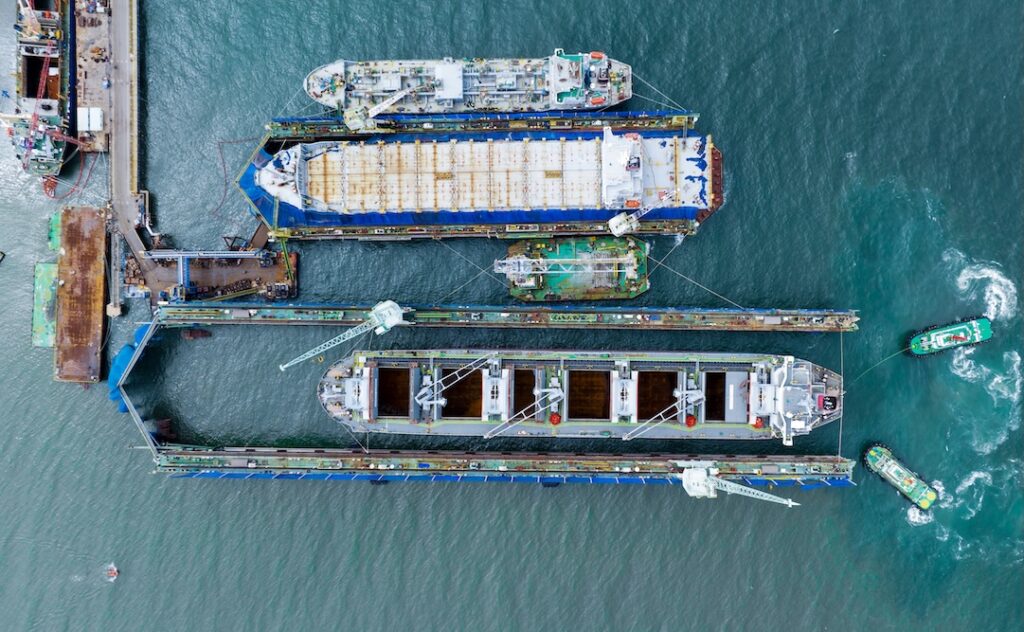When we think of pollution from ships, most people picture exhaust plumes, oil spills, or ballast water. But one of the most overlooked sources of marine pollution comes not from fuel, but from the ships themselves. The construction and maintenance of vessels release microplastics, heavy metals, and toxic coatings that infiltrate ocean ecosystems and persist for decades.
Every container ship, fishing trawler, or cruise liner is built from materials that slowly wear away into the sea. While invisible to most observers, these emissions are reshaping marine chemistry and biology.
How Vessel Construction Pollutes the Ocean
Modern vessels are built to withstand saltwater corrosion, barnacle buildup, and constant abrasion. To achieve this, shipbuilders rely on plastics, paints, antifouling coatings, and synthetic composites. Over time, these materials degrade, flake, and leach into surrounding waters.
Sources of Microplastic Pollution
- Hull coatings: Specialized paints and sealants contain polymers that erode under friction. Tiny fragments enter the water each time a ship moves.
- Fiberglass and composites: Used in smaller vessels, these materials release microfibers as they break down.
- Protective plastics: Cabling, insulation, and on-deck materials degrade in sun and salt, fragmenting into microplastics.
Sources of Toxic Pollution
- Antifouling paints: Often contain copper, zinc, or biocides to prevent barnacle growth. These toxins leach directly into marine ecosystems.
- Heavy metals: Construction and repair shed particles of lead, chromium, and other metals.
- Solvents and sealants: Used in shipyards, these chemicals enter waterways during cleaning, sanding, or repainting.
The combined effect is a steady drip of pollution from construction to operation to dismantling.
Scale of the Problem
- The International Maritime Organization (IMO) estimates that ship coatings alone account for up to 30% of all microplastic particles entering oceans from paint sources.
- Shipbreaking yards — especially in South Asia — release hundreds of thousands of tons of hazardous waste annually into coastal waters.
- The global fleet is growing: over 50,000 merchant vessels are currently in operation, each contributing invisible but constant pollution.
Unlike oil spills, which are dramatic and visible, this pollution is chronic, widespread, and largely unregulated.
Ecosystem Impacts
Marine Life
- Filter feeders: Mussels, clams, and sponges ingest microplastic particles shed from vessel coatings.
- Fish: Microplastics enter digestive tracts, reducing feeding efficiency and growth.
- Top predators: Toxins from antifouling paints bioaccumulate, threatening sharks, dolphins, and seabirds.
Coral Reefs
- Paint flakes and toxins settle on reef systems, stunting coral growth and increasing vulnerability to disease.
Seafloor Sediments
- Heavy metals and microplastics sink, creating contaminated layers that persist for decades and affect benthic organisms.
The long lifespan of ships means these impacts accumulate, slowly degrading ecosystems across global shipping routes.
Human Impacts
Ocean pollution doesn’t stop at the sea.
- Seafood safety: Microplastics and toxins ingested by fish move up the food chain to humans.
- Coastal livelihoods: Communities near shipyards or shipbreaking sites face contaminated water and reduced fisheries.
- Tourism: Beaches near shipping hubs often accumulate visible paint flakes and debris from vessel maintenance.
The costs are borne disproportionately by coastal communities, not by the global shipping industry.
What’s Being Done
Regulations and Initiatives
- IMO restrictions: Some toxic antifouling agents like TBT (tributyltin) have been banned, but replacements still leach metals and biocides.
- EU ship recycling rules: Require environmentally sound dismantling, though enforcement is limited.
- Paint innovation: Research is underway into silicone-based and biodegradable hull coatings.
Gaps in Action
- Microplastic emissions from vessel coatings remain largely unregulated.
- Shipbreaking in South Asia (Bangladesh, India, Pakistan) continues with poor environmental safeguards.
- Monitoring of coastal water near ports and shipyards is minimal.
Toward Circular Solutions
A circular economy approach could reduce the impact of vessel construction:
- Alternative coatings: Biodegradable or biomimetic materials that resist fouling without releasing toxins.
- Closed-loop recycling: Proper dismantling and material recovery at the end of vessel life.
- Modular ship design: Components built for disassembly and reuse, not disposal.
- Material transparency: Mandating disclosure of toxins and polymers used in ship construction.
These solutions require collaboration between shipbuilders, regulators, and consumers who rely on global shipping.
What You Can Do
- Support stricter regulation of shipping emissions, including microplastics.
- Choose products and seafood from companies committed to sustainable shipping practices.
- Raise awareness: most people have never heard that ships shed microplastics, yet it’s a major source of ocean pollution.
Individual voices can push industries and policymakers toward accountability.
FAQs
Are all vessel coatings toxic?
Not all, but many still rely on copper or biocides. Safer alternatives exist but are more expensive and less adopted.
Do microplastics from ships really matter compared to consumer waste?
Yes. The scale of global shipping means vessels contribute significant microplastic loads in heavily trafficked routes.
Is ship recycling sustainable?
It can be, but most shipbreaking today occurs in unsafe, unregulated yards that release toxins directly into the environment.
Final Thoughts
Ships keep global trade moving, but the vessels themselves are hidden polluters. From the moment they’re constructed to the day they’re dismantled, they shed microplastics and toxins that poison ecosystems, wildlife, and people.
Unlike fuel emissions, which are increasingly regulated, vessel construction pollution remains in the shadows. It’s time to bring it into the light — and to demand shipping systems that don’t poison the very oceans they depend on.









Reader Interactions